Division of Environmental Quality Director: Art Goodin
Unprotected cross-connections are health hazards and have the potential to introduce contamination into the drinking water delivered to customers. No customer of a community water system shall cause or allow the construction or maintenance of an unprotected cross-connection. A community water system is one that serves at least 15 connections or at least 25 of the same people on a year-round basis.
What is a cross-connection?
A cross-connection is an actual or potential link between a source of contamination and a drinking water supply. Cross-connections are fixtures with direct connections (swimming pools, fire sprinkler systems, boilers, etc.) or submerged inlets (lawn sprinklers, drinking fountains, utility sinks, etc.).

What is backflow?
Backflow is the unwanted reversal of flow from either a loss of pressure in the water supply line (backsiphonage) or an increase in pressure on the customer side (backpressure). Common situations where backsiphonage occurs are water main breaks or firefighting events. These events create low pressure in the distribution system whereby contaminants may enter the drinking water supply. Backpressure can occur when the pressure in a buildings piping, for instance a boiler system, exceeds the pressure in the water supply line, causing liquid from the customer’s line to move into the water supply.
What is backflow prevention?
Backflow prevention, or cross-connection control, is the process by which backflow hazards are identified and eliminated. Backflow hazards are eliminated by either removing the source of contamination, removing the unprotected cross-connection or installing a backflow prevention assembly. Community water systems and customers of community water systems with identified backflow hazards are required to implement backflow prevention in accordance with 10 CSR 60-11.010.
Do I need to implement backflow prevention at my residence or business?
Residential facilities that receive water from a community water system are exempt from this rule unless a cross-connection is specifically identified. The most common examples of residential cross-connections that require backflow prevention are in-ground lawn sprinkler systems, swimming pools, hot tubs and fire sprinkler systems. Contact your water supplier to determine if backflow prevention is required at your residence.
Businesses that receive water from a community water system must install backflow prevention in accordance with 10 CSR 60-11.010 if a potential or actual connection exists between a source of contamination and the water supply. The most common example of businesses that require backflow prevention are manufacturing and processing plants, medical facilities, laboratories (including school chemistry and biology labs), and buildings with boilers, fire sprinkler systems, or irrigation systems. Contact your water supplier to determine if backflow prevention is required at your business.
What is a backflow prevention assembly?
A backflow prevention assembly is a mechanism to prevent backflow. The department recognizes three types of backflow prevention assemblies: air gaps, reduced pressure principle assemblies (RPZ) and double check valve assemblies. An air gap is a physical separation between the water supply and a customer’s internal piping system. A reduced pressure principle assembly is the highest level of mechanical backflow protection. All of these devices require periodic maintenance and annual testing.
What type of backflow prevention assembly is required?
The type of assembly required depends on the type of hazard present. Backflow hazards that have the potential to threaten public health require an air gap or a reduced pressure principle assembly. Where there is a lesser hazard that has the potential to damage the water system or degrade the aesthetic quality of the water, a double check valve assembly is acceptable. A list of hazards by classification type (not all-inclusive) is included in 10 CSR 60-11.010.
The department requires backflow prevention assemblies installed at community water systems be approved by the Foundation for Cross-Connection Control and Hydraulic Research at the University of Southern California or the American Society of Sanitary Engineering. Information about approved assemblies is available on the department’s Backflow Prevention webpage. Water suppliers may have more stringent requirements. Contact your water supplier to determine the appropriate assembly for your home or business.
Must I have my backflow prevention assembly tested?
Yes. To ensure that each backflow prevention assembly is in working order, the customer must have each assembly inspected and tested by a certified backflow prevention assembly tester at the time of construction or installation and annually thereafter. If the tester finds the assembly is not working, you must arrange to have it repaired and tested again. It is your responsibility to pay for the test and repairs. The tester is required to provide a copy of the test report to you and the water supplier. To obtain a list of certified backflow prevention assembly testers in your area, check the department’s website or contact your water supplier.
Does the backflow prevention assembly protect my entire facility?
Backflow prevention applied at a customer’s service line to protect the community water system is called containment. Containment does not protect drinking water plumbing within a building or facility.
Backflow prevention applied within a building to protect drinking water plumbing from process plumbing is called isolation. Isolation backflow prevention is not covered by 10 CSR 60-11.010, but may be required by your local plumbing codes. Check with your local code enforcement agencies to see what standards apply in your area.
What right does the supplier of water have to turn off water to a customer that fails to test their backflow prevention assembly annually?
10 CSR 60-11.010 requires the supplier of water to disconnect the customer from the community water system when the supplier of water has knowledge the customer is failing or refusing to proceed without delay to correct any violations of the rule after being notified to do so. The local governmental authority (ordinances or rules) may also require this, or the department may order the community water system to disconnect the customer if the customer fails to comply with this rule.
What can I do at home?
Check with your water supplier to see if your building needs backflow prevention. If your water supplier determines that your home requires a backflow prevention assembly, contact a certified backflow prevention assembly installer. All backflow prevention assemblies should be installed in accordance with manufacturer’s recommendations. Once installed, you must have the assembly tested annually by a certified backflow prevention assembly tester.
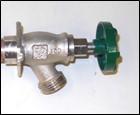

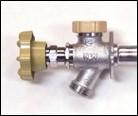
Do NOT:
- Submerge a hose in a bucket, pool, tub, or sink.
- Use garden hose spray attachments without a backflow prevention device.
- Connect waste pipes from water softeners or other treatment systems to the sewer, submerged drain pipe, etc.
- Use a hose to unplug blocked toilets or sewers.
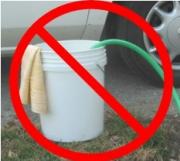
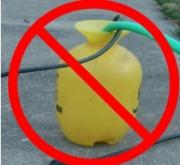
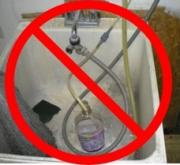
Do:
- Keep the ends of hoses clear of all possible contaminants.
- If not already equipped with a built-in vacuum breaker, install hose bib type vacuum breakers on all threaded faucets around your home.
- Install an approved backflow prevention assembly on all in-ground lawn irrigation systems.
For more information about cross connection control and backflow prevention, please visit the department’s Backflow Prevention webpage.
For additional assistance
Please contact your local regional office for more information. Call 800-361-4827 or visit the department webpage for a map and list of the department’s regional offices.
Central Field Operations 573-522-3322
Northeast Region Office 660-385-8000
Southwest Region Office 417-891-4300
Southeast Region Office 573-840-9750
Kansas City Region Office 816-251-0700
St. Louis Region Office 314-416-2960
Nothing in this document may be used to implement any enforcement action or levy any penalty unless promulgated by rule under chapter 536 or authorized by statute.
For more information
Water Protection Program
Division of Environmental Quality
P.O. Box 176
Jefferson City, MO 65102-0176
United States
